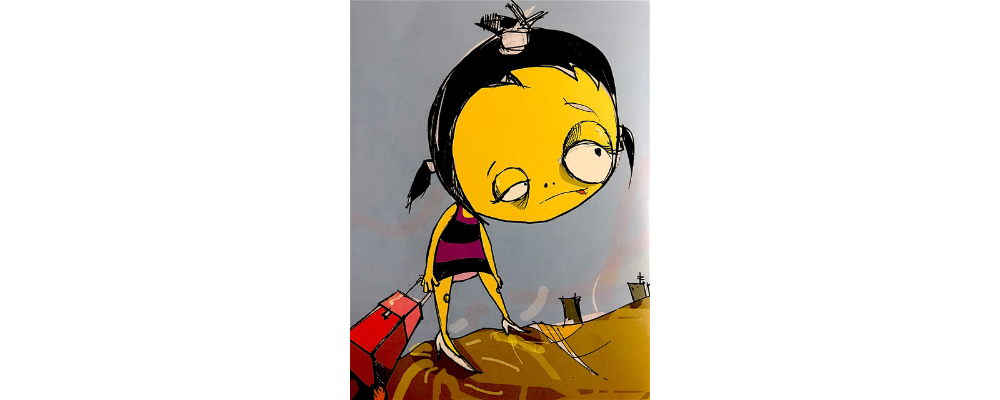Gender is terminologically the man and woman identity originates due to psychologic, behavioural, social and cultural factors. There are several parameters of this roughly defined gender notion.
Gender is terminologically the man and woman identity originates due to psychologic, behavioural, social and cultural factors. There are several parameters of this roughly defined gender notion. These parameters are sexual identity, gender bias, gender discrimination and gender roles. (Vatandaş, 31). In this context, Vegetarian Cinderella, written by Nunila Lopez illustrated by Myriam Cameros, ironically criticises tales which are frequently told the children, and drums gender roles set by society to the readers, in gender context. Narrators state by their own words that the narration is “a realist tale for adults”. Besides, the narration may enable children in puberty to criticise the gender roles which are provided to them.
The narration starts the same as the Cinderella tale which we are familiar with but does not go on the way it is expected. Here we face a Cinderella who has to cook partridge for the prince even though she, herself a vegetarian and has to wear glass shoes all day which pinches her feet. She is uncomfortable with this situation however, everyone around her dictates that she would not be able to find someone better than the prince and that she must not complain about the shoes. Only one among others reminds her who she was: “But weren’t you vegetarian? And weren’t you used to walk barefooted?” These words shape Cinderella up. She, herself, is the one who can save her. Cinderella yells out as “Enough!” and then The Enough Fairy, who is plump, hairy and brunette, shows up. Arrival of The Enough Fairy makes Cinderella cry for all the things she went through and at the end she feels so good as she never felt before. Firstly, she leaves the prince, then the shoes and lastly the partridge. When she is alone, she realises that physical properties were not important. She learns to trust in and to spare time for herself. Throughout this process she meets other people who resemble her. These people are chracters from tales who got rid of the roles provided to them.
If we were to comment on the narration and gender notions together, gender bias and gender roles which are among gender parameters show up several times throughout the text. Gender bias is defined in a study conducted by Celalettin Vatandaş as “beliefs on the aspect two sexes differentiate, which behaviours, appearances and characteristics peculiar to women and men, and which differences should be between the two sexes.” (33) Cinderella’s getting married with the prince on the basis she thinks that he is the only one to save her is supporting this definition. The one to save a woman is a man, women need men and that is why they have to be with a man/married to a man. Cinderella’s being commanded by people around her that she should not be complaining when she complains about her situation may also be regarded as a reference to how a gender should behave. Definition of gender role, which is another parameter, is an individual’s behaving according to behavioural patterns, characteristics and attitudes that define femininity and masculinity in a specific culture. According to general role theory, these roles are learned, socialised and are internalised (34). When the narration considered in this context, Cinderella’s regarding the prince as a saviour, cooking partridge everyday just because the prince likes despite the fact that she is a vegetarian and wearing glass shoes all day are only because she learned and internalised the role shaped up for women. The prince’s expecting Cinderella to cook partridge every day and criticising her bitterly when he does not like the meal are also the indicators that he also learned and internalised the roles shaped up for men.
Emergence of a concept like gender was, of course, inevitable. Upon the need for division of labour between women and men, the roles shaped up for men and women were first learned, then started to be socialised, and internalised by everyone (34). Even though these roles helped them to be accepted within the society at first, they started to hinder people’s getting to know who they are before the changing and developing societies. Factors such as people’s insights, self-respect, self-trust evolved to be vanished within the roles that are shaped up for them. Definitions and narrations formed on this topic became more and more important in terms of raising awareness and people’s realising their own personalities. Vegetarian Cinderella offers ironic criticisms for raising this awareness. The Enough Fairy’s being plump, hairy and brunette contrary to what was expected is a good example to overcome the gender prejudices. After this, Cinderella’s realising herself is a significant step in terms of her regaining self-respect and self-trust which she lost when trying to pretend according to the role shaped up for women by the society.
The narration has brought up a critical point of view to the concept of gender on the basis of famous tales and became a realistic tale not only for “adult” readers but also readers at puberty. Young reader who learns the roles shaped up for themselves through tales at a very early age will raise self-awareness and self-prestige on this topic. Narrators’ telling how was this narration formed with the readers at the end and narrators’ finding themselves by going through these circumstances enhances book’s level of reality.
Bibliography
Lopez, Nunila ve Cameros, Myriam. Vejetaryen Külkedisi. Ankara: NotaBene Yayınları, 2015.
Vatandaş, Celalettin. “Toplumsal Cinsiyet ve Cinsiyet Rollerinin Algılanışı.” Sosyoloji Konferansları. İstanbul:
İstanbul Üniversitesi, 2011.

